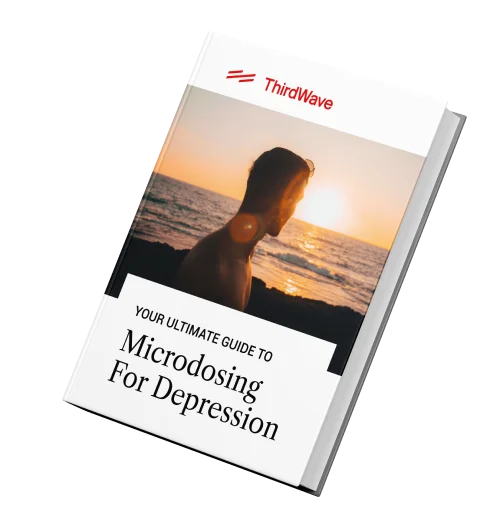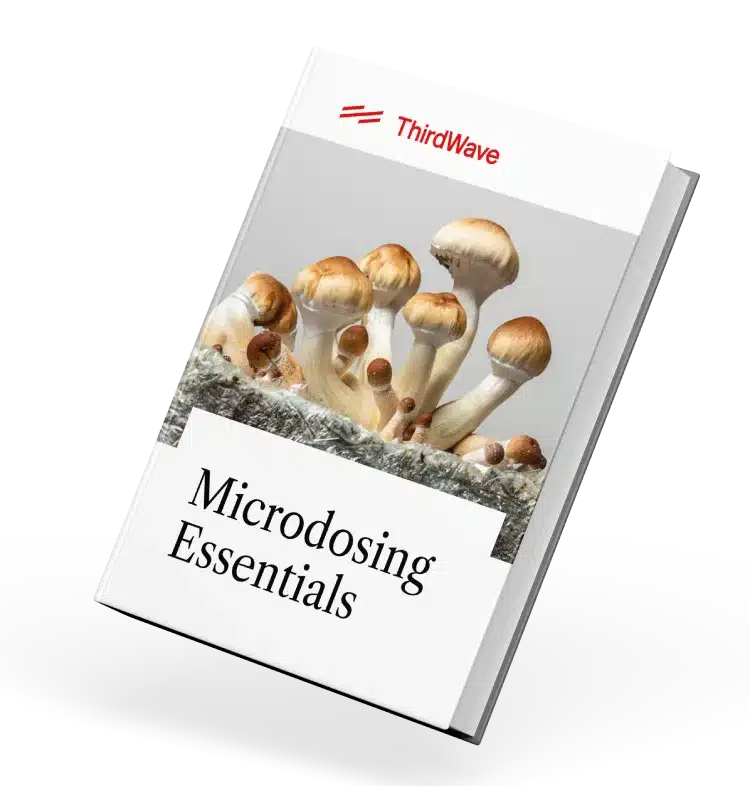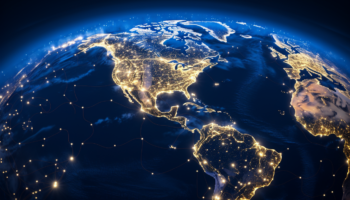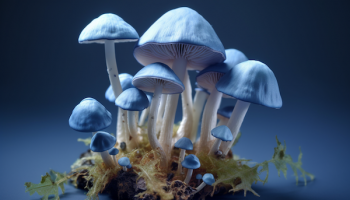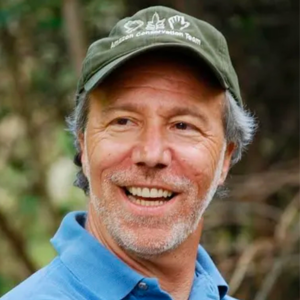The Ultimate Guide to
Psilocybin Mushrooms
(Magic mushrooms, Shrooms, psilocybin)
Psilocybin is a largely illegal substance and we do not encourage or condone its use where it is against the law. However, we accept that illegal drug use occurs and believe that offering responsible harm reduction information is imperative to keeping people safe. For that reason, this guide is designed to ensure the safety of those who decide to use psilocybin.
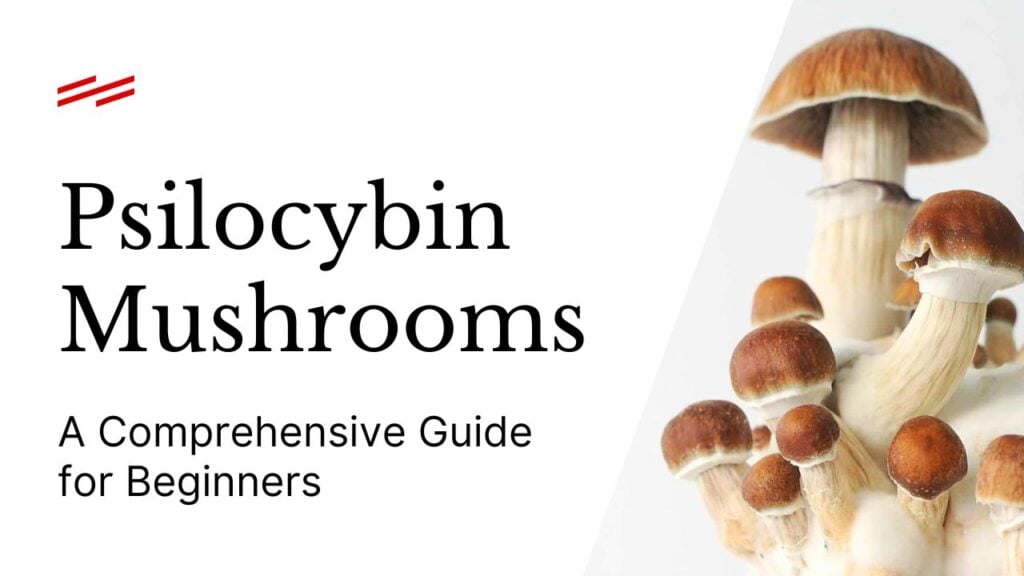
Overview
01Psilocybin mushrooms are more than just a drug and sacrament, however. They’ve been used in therapeutic settings to treat a variety of ailments and disorders including cluster headaches, obsessive-compulsive disorders, anxiety, depression, post-traumatic stress disorder, and addiction, and a recent resurgence in research into psilocybin’s therapeutic effects is showing promising results.
While psilocybin mushrooms have been decriminalized in three North American cities (see “Legality” for details), they are still illegal at the federal level and are categorized as a Schedule I controlled substance in the U.S. Recently, however, the Food and Drug Administration (FDA) and the Drug Enforcement Agency (DEA) have allowed several small, highly controlled human studies on their potential for use in medical and psychiatric settings. The FDA also designated psilocybin as a “breakthrough therapy” for depression, which could accelerate the process of psilocybin drug development and review.
Grow 1 Year's Worth of Microdoses in Just 6 Weeks
Third Wave partnered with top mycologists to create the world’s easiest and best mushroom growing program (kit, course, and expert support).
- Pre-sterilized and sealed
(ready to use out of the box) - Step-by-step video and text course
- Access to growing expert in community
- Make your first harvest in 4-6 weeks
- Average yield is 1 - 4 ounces (28-108g)
- Fits in a drawer or closet
- Enter info for Third Wave discounts:
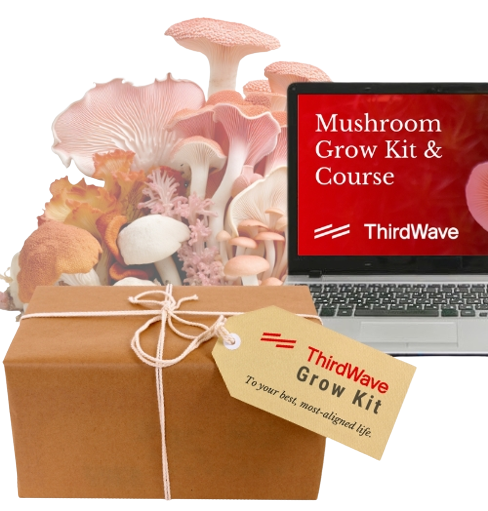
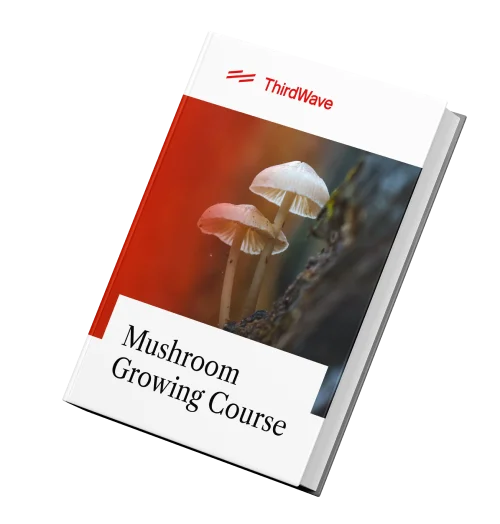
Grow 1 Year's Worth of Microdoses in Just 6 Weeks
Third Wave partnered with top mycologists to create the world’s easiest and best mushroom growing program (kit, course, and expert support).
- Pre-sterilized and sealed
(ready to use out of the box) - Step-by-step video and text course
- Access to experts in community
- Make your first harvest in 4-6 weeks
- Average yield is 1 - 4 ounces (28-108g)
- Fits in a drawer or closet
- Enter info for Third Wave discounts
Experience
02Golden Teachers is one of the most popular magic mushroom varieties, especially for psilocybin newbies. Learn more about how it feels to journey with Golden Teachers from a recent Third Wave blog.
At Third Wave, we provide well-researched, high-quality information specific to the classic psychedelics – and how they can be used to help people like you live more vibrant lives.
Download everything you need to know about safely using microdosing to help relieve symptoms of depression.
What to expect
Psilocybin mushrooms are generally eaten in their whole, dried form and most people agree they don’t taste great. To mask the flavor, some people brew the mushrooms into a tea, put them in Nutella or peanut butter, blend them with a juice or smoothie, mix them with citrus juice (known as Lemon Tekking), or grind them up and put them into capsules.
Each of these ways will have a slightly different effect. Drinking a mushroom tea, for example, will bring on the effects faster than eating them; swallowing capsules will make the effects come on a little later.
A typical trip on a moderate dose of psilocybin mushrooms (1-2.5g) includes an increased intensity of emotional experiences, increased introspection, and altered psychological functioning in the form of “hypnagogic experiences,” which is the transitory state between wakefulness and sleep. Brain imaging studies show that a psilocybin trip is neurologically similar to dreaming, which gives you a good idea of the mindset you’re entering when undertaking a psychedelic experience.
During a psilocybin experience, you can expect to experience perceptual changes, synesthesia, emotional shifts, and a distorted sense of time.[1] Perceptual changes can include visuals such as halos around lights and objects as well as geometric patterns when your eyes are closed. You may also experience vivid colors, tracers, distorted vision, and a sense of the world breathing around you. Learn more about what causes visuals In psychedelic trips.
Thoughts and emotions can change, too. It’s not uncommon to have a sense of openness to thoughts and feelings that you avoid in your everyday life, as well as a sense of wonder and delight with the world around you, the people in your life, and your own mind. You may also feel a sense of peace and connection with the world.
Strong emotions, both enjoyable and challenging, are common during a journey. When undesirable feelings do arise, it’s best not to resist but rather let the feelings run their course.
Many people who have reported the presence of strong negative emotions also report feeling a simultaneous sense of calm acceptance and detachment, especially if they don’t resist and remind themselves that the emotions are temporary. Resisting the emotions can lead to a “bad trip.” (See “Bad trips” for more details.)
Physical side effects vary from person to person, but they can include a change in heart rate (up or down), change in blood pressure (up or down), nausea, increased tendon reflexes, tremors, dilated pupils, restlessness or arousal, and trouble with coordinated movement. Some also report feeling deeply relaxed and calm.
One study also found that psilocybin can cause headaches that last for up to a day in healthy individuals.[2] None of the subjects reported severe headaches, however, and psilocybin is actually used to treat a clinical condition called cluster headaches (see “Therapeutic Uses” section).
Phases of a Psychedelic Mushroom Trip
The four basic phases of a mushroom trip are ingestion, onset, the trip (peak), and the comedown. Each phase comes with its own set of perceptions and observations.
The peak, which typically occurs a couple of hours after ingestion (unless you’re Lemon Tekking) results in the most intense sensory and psychological shifts. No matter what phase you’re in, it’s important to relax and remember that what you’re experiencing is temporary, and there is nothing to fear.
Check out our detailed guide on what to expect during a psilocybin mushroom trip for more information.
Bad Trips
Anyone curious about trying psilocybin mushrooms for the first time will inevitably worry at some point about having a “bad trip,” which can happen. A bad trip might include dysphoric hallucinations, uncontrollable paranoia, and reckless behaviors.
However, the risks associated with a psilocybin experience can be minimized by adhering to the 6S’s of the psychedelic experience—set, setting, substance, sitter, session, and situation. Being prepared and knowing your motivations before undertaking a psychedelic experience can help manage the risks.
Also, it’s best to ignore the many portrayals of bad trips in popular culture. These scenes rarely capture the experience accurately and allude to bad trips being more common and out of your control than they actually are. Most bad trips can be managed with interpersonal support and without pharmaceutical intervention. [3]
Effects
03Pharmacology
Psilocybin is the active psychedelic ingredient in psychedelic mushrooms. The threshold dose for feeling the effects from dried mushrooms is typically in the 0.2-0.5g range, though it varies for each person. A moderate dose in the 1-2.5g range, taken orally, typically produces effects that last from three to six hours. Psilocybin is about 100 times less potent than LSD and 10 times less potent than mescaline.
Read More: LSD vs Shrooms
When you take psilocybin, your body metabolizes the substance into psilocin, both of which produce the psychedelic effects. Psilocybin and psilocin primarily interact with serotonin receptors in the brain and have an especially high affinity for the 5-HT (serotonin) 2A subtype receptors. In rodents, psilocybin has shown a strong interaction with receptors in hub regions of the brain that integrate sensory experiences. This could explain effects such as synesthesia—the experience of mixing sensory modalities, such as hearing colors or tasting sounds—and altered sensory experiences during mushroom trips.
Grow 1 Year's Worth of Microdoses in Just 6 Weeks
Third Wave partnered with top mycologists to create the world’s easiest and best mushroom growing program (kit, course, and expert support).
- Pre-sterilized and sealed
(ready to use out of the box) - Step-by-step video and text course
- Access to growing expert in community
- Make your first harvest in 4-6 weeks
- Average yield is 1 - 4 ounces (28-108g)
- Fits in a drawer or closet
- Enter info for Third Wave discounts:


Grow 1 Year's Worth of Microdoses in Just 6 Weeks
Third Wave partnered with top mycologists to create the world’s easiest and best mushroom growing program (kit, course, and expert support).
- Pre-sterilized and sealed
(ready to use out of the box) - Step-by-step video and text course
- Access to experts in community
- Make your first harvest in 4-6 weeks
- Average yield is 1 - 4 ounces (28-108g)
- Fits in a drawer or closet
- Enter info for Third Wave discounts
Effects by Dose
NOTE: The effects listed below aren’t meant to be comprehensive, particularly at the lower dose ranges. They may be subject to change as more reliable, widely representative data become available.
These dose ranges are for Psilocybe cubensis mushrooms. They may apply to other psilocybin-containing species, but some (e.g. P. semilanceata) are more potent on average.
Microdose (0.1-0.3 g)
A microdose is a sub-perceptual (unnoticeable) dose, which many people incorporate into their weekly routines. The idea behind this is to enhance levels of creativity, energy, and focus, and decrease levels of stress, anxiety, and emotional instability. Find out more in our microdosing guide. Common effects include:
- Mood enhancement
- Decreased stress
- Emotional stability
- Mindfulness, presence, and peace
- Openness and self-forgiveness
- Conversational fluidity
- Alleviation of persistent conditions such as depression, anxiety, ADD/ADHD, and PTSD
- Increased motivation (e.g. to make positive lifestyle changes)
- Increased flow states
- Clearer, more connected thinking
- Improved memory
- Increased creativity
- Easier meditation
- Enhanced athletic endurance
- Increased energy overall (without anxiety or a subsequent crash)
- Slight amplification of mood, positive or negative
- Possible manic states
- Potentially increased neuroticism
Mini-dose (0.35-0.75 g)
While a proper microdose shouldn’t be felt, a mini-dose of psilocybin takes you just above the perceptual threshold—but it’s not a full-blown trip. As one of our community members put it, a mini-dose gives you “that total expansion of being, total freeflow feeling” without losing touch with your surroundings. Common effects include:
- Mood enhancement, mild euphoria or excitement
- Mindfulness, presence, and peace
- Openness and self-forgiveness
- Introspective insights
- Alleviation of persistent conditions such as depression, anxiety, ADD/ADHD, and PTSD
- Increased motivation (e.g. to make positive lifestyle changes)
- Increased flow states
- Clearer, more connected thinking
- Enhanced senses
- Easier meditation
- Increased enjoyment of physical activity and everyday tasks
- Preference for introspection over socializing
- Increased sensitivity to light
- Very mild visuals, if any
- Possible manic states
- Difficulty focusing or thought loops
- Difficulty with some cognitive tasks
- Anxiety, agitation, or restlessness
- Difficulty or discomfort socializing
Museum dose (0.5-1.5 g)
The effects of psilocybin are more apparent with a museum dose than with a mini-dose, but a museum dose still won’t give you a full psychedelic experience. The name “museum dose,” coined by the biochemist and pharmacologist Dr. Alexander Shulgin, refers to the fact that on this dose, you can still participate in public activities (such as viewing paintings in a museum) without attracting attention. Common effects include:
- Mood enhancement, euphoria or excitement
- Mild to moderate visuals (e.g. “breathing” environments)
- Increased empathy
- Conversational fluidity
- Introspection
- Increased flow states
- Enhanced senses
- Enhanced appreciation for music, art, etc.
- Increased creativity
- Amplification of mood, positive or negative
- Altered perception of sound
- Time dilation or contraction (time passing more slowly or quickly)
- Increased sensitivity to light
- Pupil dilation
- Difficulty focusing or thought loops
- Difficulty or discomfort socializing
- Frustration at dosage (the “no man’s land”)
Moderate dose (2-3.5 g)
This is where the full psychedelic experience begins. You’ll likely see visual hallucinations, including patterns and fractals, and things like time and depth perception will be distorted. But with this dose, you’re still able to grasp your surroundings—they’ll just be highly altered. Common effects include:
- Life-changing introspective or philosophical insights
- Increased flow of ideas
- Enhanced appreciation for music, art, etc.
- Finding otherwise mundane things funny or interesting
- Clear come-up, peak, and come-down
- Amplification of emotions, whether good or bad
- Open- and closed-eye visuals (e.g. patterns, auras)
- Synesthesia
- Sensitivity to light
- Compulsive yawning
- Disorientation
- Fear and anxiety (“bad trip” experiences)
- Difficulty with cognitive tasks
- Dizziness
- Nausea
Megadose (5+ g)
A megadose brings on a total loss of connection with reality. This is where you’ll experience intense hallucinations, as well as ego death, mystical experiences, and deep introspection. Common effects include:
- Mystical experience and intense feelings of wonder
- Life-changing introspective or philosophical insights
- Ego death
- Very strong open- and closed-eye visions (e.g. memories coming to life)
- Synesthesia
- Time becoming meaningless
- Disorientation
- Compromised motor functions (sitter recommended!)
- Strong fear and anxiety (extreme “bad trip” experiences)
- Extreme difficulty with cognitive tasks
- Dizziness
- Nausea
Watch the video below to learn more about how to safely dose psilocybin mushrooms:
Interactions With Other Drugs
So far, not much data exists around psilocybin’s interaction with other drugs, whether good or bad, but it’s best to be intentional and err on the side of caution when mixing any two substances together. Here’s what we do know.
Positive Interactions
- Cannabis: Cannabis has the potential to enhance the psychedelic nature of the mushrooms, but it’s best to wait until the latter half of the experience so you don’t interfere with the insight provided by psilocybin.
- Ketamine: Psilocybin + ketamine is the classic Burning Man combination. If you combine ketamine with psilocybin, wait until the intensity of the psilocybin experience has passed before utilizing ketamine.
- MDMA: Colloquially known as “hippy flipping,” mixing MDMA and psilocybin is a common practice. While no existing research supports the safety or danger of this combination, anecdotal reports show that MDMA can enhance the psilocybin trip and even help you avoid being overcome with negative emotions.
Neutral Interactions
- Coffee: There are no known side effects to mixing coffee and psilocybin, but some believe the energy boost of caffeine can enhance the psilocybin experience.
Negative Interactions
- Alcohol: Anecdotal reports from emergency rooms suggest that abstaining from alcohol while on mushrooms is the safest and smartest bet. In fact, it’s best to abstain from alcohol while using any psychedelic.[4]
- Adderall, Xanax, SSRI antidepressants: These are powerful psychoactive drugs with largely subjective side effects, and psychedelic use should be approached with extreme caution if you regularly take any of these substances. On top of that, psilocybin is a potent serotonin agonist, which means it could interfere with any medications that alter the serotonin system.
Benefits & Risks
04Potential Benefits
Among the many historical cultures that have used them, psychedelic mushrooms have a longstanding, profound, and storied reputation as an agent for healing and change. Beyond lore, the benefits of these powerful little fungi are being recognized today in a big way. Studies into the vast and multifarious use of psychoactive mushrooms are being conducted across the United States and abroad, and evidence is strong that they are indeed drivers of personal growth. One recent study published in the Journal of Psychopharmacology found that “a single dose of psilocybin produced substantial and enduring decreases in depressed mood and anxiety along with increases in quality of life.”
Additionally, the mystical and profound experiences that occurred when psilocybin entered the American psychedelic lexicon in the 1960s are now being researched and explored in mainstream medical science. The results are promising and compelling and suggest that psilocybin could be a powerful healer.
More specifically, clinical trials involving patients dealing with life-threatening cancer have been and are currently being conducted in the United States and abroad. These trials are mainly attempting to understand the efficacy of high-dose psilocybin experiences administered in therapeutic environments as a tool for reducing the psychological stress and anxiety that often accompanies a life-threatening diagnosis. The results so far have been promising. Under double-blind, placebo-controlled conditions, a single high dose of psilocybin has been shown to reduce symptoms of psychological distress among people with terminal diagnoses, and the effects of that experience have been substantial and enduring.
Additionally, there is a growing body of research suggesting that part of why psilocybin is so effective is that it impacts neuroplasticity, or the brain’s ability to learn, grow and, most importantly, change.
Also see: Psilocybin Benefits: Magic Mushrooms & Their Many Benefits
Risks
Psilocybin is largely considered one of the safest psychoactive substances you can take. The 2017 Global Drug Survey found that psilocybin is the safest of all the recreational drugs on the market and that just 0.2% of the people who took psilocybin in 2016 needed emergency medical treatment. That’s five times lower than that for MDMA, LSD, and cocaine. Psilocybin is also non-addictive and there’s no known lethal dose, meaning that even if you have a bad trip, you’re unlikely to overdose.
That being said, taking any drug isn’t without risk. At the outset and during a trip, psilocybin can cause some physical side effects such as nausea, perspiration, numbing, and tremors. It can also lead to anxiety, panic attacks, paranoia, and mood swings. A survey published in Substance Abuse and Misuse found that up to 33% of people surveyed who had taken mushrooms experienced paranoia and anxiety at some point during their trip. Long-term physical and psychological effects are rare. When they do occur, research suggests the cause was latent psychological disorders, not the mushrooms themselves.
There is, however, something called Hallucinogen Persisting Perception Disorder (HPPD), which is commonly known as “flashbacks.” Unlike flashbacks associated with PTSD, however, HPPD is unique to psychedelics and involves perceptual changes in the weeks or months following the use of psilocybin (or other psychedelic). The prevalence of HPPD is unknown, but it’s considered a rare disorder and is not associated with any physical changes or neurological damage.
Therapeutic Use
05However, after the federal government reclassified psilocybin as a Schedule I drug in the 1970s, research on its therapeutic effects became virtually non-existent. All that has changed with the third wave of psychedelics. With anecdotal accounts of psilocybin’s therapeutic effects finally capturing the attention of medical professionals and regulators and trickling into the mainstream, today, research is being funded and conducted by many organizations, including MAPS, The Beckley Foundation, and The Johns Hopkins Center for Psychedelic & Consciousness Research. Like the research in the 60s and 70s, so far research is showing that psilocybin could have profound therapeutic effects.
Psilocybin in the Treatment of Mood and Anxiety Disorders
For years, anecdotal reports have shown psilocybin (and other psychedelics) to be an effective treatment for mood disorders such as depression and anxiety. Now in the third wave of psychedelics, this is one of the most prevalent areas of modern clinical research involving psilocybin, leading the federal government to allow some small, highly controlled studies to be conducted on the therapeutic potential of psilocybin on mood disorders. In 2011, for example, a pilot study tested the effects of psilocybin on depression and end-of-life anxiety in terminal cancer patients.[6] Patients in this study had advanced-stage cancer and a clinical diagnosis of stress or anxiety related to their disease. After psilocybin treatment, researchers observed significant improvements in measures of depression and anxiety up to six months after the trial. This study was eventually granted Phase II status by the FDA, meaning a larger study could be conducted.
Another study by a prestigious research group in London suggests psilocybin could be used to treat major depression.[7] In the study, twelve patients were given two doses of psilocybin (one low, and one high), combined with psychological support. One week after the second dose, depression scores were significantly reduced in nearly all patients, with eight out of 12 showing no symptoms of depression. Three months later, five patients were still depression-free, and four of the remaining seven had a reduction in the rating of their depression from “Severe” to “Mild or Moderate.”
At Third Wave, we provide well-researched, high-quality information specific to the classic psychedelics – and how they can be used to help people like you live more vibrant lives.
Everything you need to know about safely using microdosing to help relieve symptoms of depression.
Psilocybin treatment has also been shown to successfully reduce symptoms of obsessive-compulsive disorder (OCD) in a small study of people who didn’t respond to conventional serotonin reuptake inhibitor (SRI) drug therapy.[8] In this study, all patients showed a reduction in OCD symptoms ranging from 23% to 100%.
Psilocybin studies continue to unfold, proving its transformative healing powers. Check out Third Wave’s curated list of cutting-edge research on psilocybin for depression and anxiety in our recent 2021 news article.
Psilocybin in the Treatment of Addiction
In the 50s and 60s, “classic psychedelics” were used in preclinical trials to treat addiction with promising results. But again, once many of these psychedelics were made illegal in the U.S. and most of Europe, research into their use for therapeutic applications came to a halt. But recent years have seen a resurgence of research looking at psilocybin and other psychedelics as promising treatments for addiction.
In a 2015 study, for example, psilocybin proved useful in treating alcoholism as part of an assisted treatment plan.[9] Significant reductions in drinking and abstinence from drinking were reported after psilocybin administration as part of a treatment program. Learn more about psilocybin for alcoholism research.
Psilocybin also appears to be a potential tool in helping people quit smoking tobacco. In a recent trial, 15 smokers experienced two to three psilocybin sessions as part of a larger cognitive-behavioral therapy program for smoking cessation. Twelve of the participants (80%) were able to successfully quit.[10] By comparison, conventional smoking cessation method success rates—including gum, patches, and going cold turkey—have about a 35% success rate.
Psilocybin in the Treatment of Cluster Headaches
More intense but shorter in duration than migraines, cluster headaches are often described as the most painful and disruptive type of headache and they interfere significantly with a person’s life.
So far no systematic studies have been published that describe psilocybin’s potential to treat cluster headaches, but anecdotal reports claiming this use have caught the attention of the medical community. In the mid-2000s, medical professionals began taking notice of psilocybin and LSD as possible treatments for cluster headaches after some of their patients reported remission of their condition following recreational psychedelic use and subsequent self-medication.[11]
One recent survey reported that psilocybin could be a more effective treatment of cluster headaches than currently available medications, with nearly 50% of sufferers reporting psilocybin as a completely effective treatment. [12] Several clinical studies into this use are underway and more research should be available soon. [13] [14]
Does Psilocybin Re-Wire the Brain?
Some researchers are beginning to theorize that many of psilocybin’s beneficial effects on mental health conditions may be due to its ability to “reset” the Default Mode Network (DMN), the brain’s control system. An overactive DMN been linked to depression and other mood disorders, and psilocybin has been shown to dramatically reduce DMN activity in the area.[15] This has been linked to antidepressant effects.[16]
Read more about the relationship between psychedelics and the DMN here.
Third Wave partnered with top mycologists to create the world’s easiest and best mushroom growing program (kit, course, and expert support). Third Wave partnered with top mycologists to create the world’s easiest and best mushroom growing program (kit, course, and expert support). Grow 1 Year's Worth of Microdoses in Just 6 Weeks
(ready to use out of the box)Grow 1 Year's Worth of Microdoses in Just 6 Weeks
(ready to use out of the box)
Personal Growth
06Anecdotal reports have long supported these initial findings. After a psilocybin experience, people often report a greater appreciation of music, art, and nature along with more tolerance for others and increased creativity and imagination.
A 2011 study also found that more than a year after participants had a single psilocybin experience, their self-reported measures of openness remained significantly elevated, which researches in this study and beyond attribute to a somewhat mysterious but powerful aspect of a mushroom trip: the mystical experience.
In this case, a mystical experience is defined as “feelings of unity and interconnectedness with all people and things, a sense of sacredness, feelings of peace and joy, a sense of transcending normal time and space, ineffability, and an intuitive belief that the experience is a source of objective truth about the nature of reality.” The religious identification of people who have reported having a mystical-type experience during a mushroom trip span the spectrum, but interestingly the profundity of such experiences don’t seem to correlate to religious belief—even atheists have reported the importance of their psilocybin-induced mystical experiences. Additionally, research has shown that the more intense the mystical experience, the greater the positive, long-term changes a person sees.[20]
These subjective effects, such as feelings of interconnectedness, are likely a result of psilocybin’s ability to decrease the interconnectivity of integration hubs in the brain.[21] In plain speak, that means psilocybin allows for more “cross-talk” between regions of the brain that are typically segregated. Researchers speculate that this enables a state of “unconstrained cognition,” meaning the ways we typically organize, categorize, and differentiate the aspects of conscious experience are broken down, and thinking becomes more flexible. [22] To understand how this might be beneficial, it helps to know that similar brain activity patterns are also observed during various states of meditation. For more about this, see our blog post about combining psychedelics and meditation.
It might not surprise you, then, to learn that research has shown that psilocybin can be used to enhance one’s spiritual practice. In a recent study, 75 participants engaged in a six-month spiritual course involving meditation, awareness, and self-reflection. During the course, participants were given either a low or high dose of psilocybin. At the end of the six months, the participants given the high dose of psilocybin showed significantly greater improvements in measures of spirituality such as interpersonal closeness, life meaning, death transcendence, and forgiveness.[23]
With all this in mind, many people believe psilocybin (and other psychedelics) could be a key component of self-improvement and self-optimization. By occasioning the experience of feeling connected to the universe (in whatever individual form that takes) and confronting the deepest part of yourself, many believe psilocybin can help you take the necessary steps to become the best version of yourself you can be.
Considering a psilocybin experience for personal growth? Check out Third Wave’s vetted guide of psilocybin retreat centers around the world.
Microdosing
07While the modern history of psychedelics reaches back to the 1950s, interest in microdosing surged with the publication of Dr. James Fadiman’s 2011 book, The Psychedelic Explorer’s Guide: Safe, Therapeutic, and Sacred Journeys. The book explores microdosing as a subculture of psychedelic use. While many indigenous cultures, as well as modern professionals, have used microdosing to unlock a host of benefits, Fadiman’s book formally introduced the term “microdosing” into the psychedelic mainstream.
Fadiman’s ongoing research also serves as one of the few modern studies into the effects of microdosing specifically. While there have been some recent clinical studies examining the efficacy of microdosing, we know more about what large doses of psychedelics do to the brain. But chances are microdosing does similar work, just on a smaller level. To learn more about microdosing, read our comprehensive microsing guide.
Sometimes hope comes in micro-doses. This guide will walk you through the process and how to best use the healing potential of psychedelics in a safe, intentional way to heal depression. Sometimes hope comes in micro-doses. This guide will walk you through the process and how to best use the healing potential of psychedelics in a safe, intentional way to heal depression. Get Your FREE Ultimate Guide To Microdosing for Depression.
Get Your FREE Ultimate Guide To Microdosing for Depression.
Legality
08Attending Legal Psilocybin Retreats
Third Wave has created its own psychedelic provider directory for you to find curated, legal psilocybin retreats. All retreats listed have either been verified or rigorously vetted by the Third Wave team, so you can feel confident knowing that these options are worth considering in this vulnerable and transformative experience.
Buying Psilocybin Mushrooms
Psilocybin has been illegal in most countries for decades, so make sure to familiarize yourself with local laws before buying psilocybin mushrooms. In the Netherlands, for example, it’s possible to purchase “magic truffles” that contain psilocybin without breaking the law due to a legal loophole. Psilocybin in some form is also legal in Brazil, the British Virgin Islands, and Jamaica.
On May 7, 2019, citizens of Denver, Colorado, voted to decriminalize psilocybin mushrooms.[24] This means it’s no longer a punishable offense for adults aged 21 and older to possess them for personal use. This doesn’t make them legal, though. If you’re caught selling or otherwise distributing psilocybin mushrooms, and possibly even growing them, you could still face criminal charges. The law remains unchanged for the rest of Colorado—at least for the time being.
In June the same year, Oakland, California, followed suit with an amendment of its own: Council members voted unanimously to decriminalize not just psilocybin mushrooms but all “entheogenic plants” containing indoleamines, tryptamines, and phenethylamines. Like in Denver, this only applies to adults aged 21 years and older and doesn’t include synthetic substances derived from plants or fungi, such as LSD. However, unlike in Denver, it also decriminalizes (or rather deprioritizes for law enforcement) the cultivation and distribution of the specified psychedelics—which includes psilocybin mushrooms.[25][26] Oakland is implementing a “Grow, Gather, Gift” framework for legalization, which encourages people to grow their own, gather their own, and gift their own plant medicines rather than establishing a for-profit market.
Read our article on the legality of psilocybin mushrooms.
Before sourcing legal mushrooms, it’s important to consider how you want to consume them. To help you decide, read more about the differences between mushroom capsules, edibles, teas, and raw forms in our recent article. Then check out, Third Wave’s Ultimate Guide to Sourcing Psychedelic Medicines for specific vendor recommendations, legal alternative options, and access to our entire library of psychedelic guides.
Psilocybin Mushrooms in the US
Psilocybin mushrooms may be federally banned in the US, but you can legally possess magic mushrooms in certain cities and states around the country. Voters in the 2020 elections were more vocal than ever–they want to decriminalize psychedelic mushrooms and make them available for therapeutic use.
Check out the most recent US ballot votes in our 2021 Psilocybin News article.
Growing and Harvesting Psilocybin Mushrooms
While psilocybin is illegal at the federal level in the U.S., psilocybin mushrooms were deemed legal to grow and possess (as long as they’re not dried) in New Mexico in 2005. In 1978, the Florida supreme court ruled that harvesting wild psilocybin mushrooms was effectively legal until the state legislature said otherwise. So far, no new laws have been passed to regulate the harvest of wild-picked psilocybin mushrooms.
With the exception of three states, psilocybin mushroom spores are perfectly legal to possess in the U.S., as the spores don’t contain psilocybin or psilocin, the chemicals that are specifically regulated by federal law. However, despite the spores being legal, growing mushrooms from the spores is still considered an illicit activity.
Are you feeling confused by the legal ambiguity of spores vs mushrooms? Are you wondering how to acquire spores without crossing lawful boundaries? Learn more about experimenting with psilocybin spores.
Third Wave also offers extensive resources for growing psilocybin mushrooms and storing them for maximum shelf life.
Are you missing that gardening gene? No worries. If you’d prefer to buy psychedelic medicine online, Third Wave’s Ultimate Guide to Sourcing Psychedelic Medicines provides recommendations for legal sourcing in most countries. In addition, you’ll receive step-by-step instructions for navigating the Dark Web and exploring lesser-known (legal) psychedelic alternatives with similar effects.
For other legal mushroom products that can boost your health (without the psychoactivity!), check out Four Sigmatic.
History & Stats
09Brief history
Archaeological evidence from the Sahara desert suggests that humans have been using psychedelic mushrooms for 7,000 years or more and mushrooms are represented in prehistoric art across many geographic regions.[27] In most cases, they’re thought to be religious symbols, often in the context of ceremonies celebrating rights of passage. It’s thought among some that if our ancestors did use mushrooms, the experience may have influenced prehistoric culture, from art to religion to social values that regulated everyday life.
Listen to our podcast episode with Jerry Brown talking about Were Early Christians Tripping On Psilocybin Mushrooms? or Click here to read the transcript
Some take this theory pretty far. In the 90s, ethnobotanist and psychonaut Terence McKenna posited the “Stoned Ape Hypothesis,” which suggests that when early humans or pre-human hominids ingested psychedelic mushrooms, it triggered intellectual advancements that lead to evolutionary benefits—include the mind as we know it today. It should be noted that the scientific community regards this hypothesis with skepticism due to a lack of evidence support some of its assumptions.
There are, however, extensive accounts of pre-Columbian psilocybin use among the Mayan and Aztec cultures of Mesoamerica, namely in Mexico and Guatemala. After conquering these areas in the 15th and 16th centuries, the Spanish forbade psychedelic mushroom use by indigenous peoples, regarding it as a savage and uncivilized cultural practice. Despite this, the indigenous shamans ignored Spanish law in secret for over 400 years and continued to use and administer these mushrooms to preserve their cultural heritage.
The first reliable account in the West of “intoxication” with psilocybin mushrooms came in 1799 when four children were accidentally fed Psilocybe semilanceata, a species of psychedelic mushroom, which their father had unknowingly gathered and cooked into a stew.
The famous Swiss chemist Albert Hofmann (who synthesized LSD) first isolated psilocybin in the lab in 1957 from Psilocybe mexicana, a species of mushroom found primarily in Central America. A year later, it was produced synthetically for the first time.[28]
Gordon Wasson, former vice president of J.P. Morgan & Company, apparently had a fascination with psilocybin mushrooms, which grew into an obsession. In 1955, he traveled to Oaxaca, Mexico, to meet mushroom shaman Maria Sabina, a member of the indigenous Mazatec Indian tribe, who introduced him to psilocybin mushrooms. On his first mushroom trip, he reported feeling as if his soul had been scooped out of his body. [29] Wasson effectively kickstarted the psychedelic mushroom movement in the West when, in 1957, Time Magazine published his photo essay, “Seeking the Magic Mushroom,” in which he detailed his experiences.
After reading of Wasson’s experiences and then traveling to Oaxaca to experience psilocybin mushrooms for themselves, Timothy Leary and Richard Alpert, researchers at Harvard University, founded the Harvard Psilocybin Project, which got them fired shortly after. So they did what any jobless, charismatic academics would have done in 1962: they started a psychedelic movement. Psilocybin mushrooms were quickly adopted into the 1960s counterculture.
In 1971, psilocybin was listed in the UN’s Convention on Psychotropic Substances as a Schedule I drug in the U.S., making it illegal for all purposes. [30] However, psilocybin mushrooms were not part of the UN convention, which, to this day, allows countries who have signed the convention (essentially a treaty) to regulate mushrooms that naturally contain psilocybin as they see fit. However, psilocybin mushrooms are illegal in most countries today, although there are exceptions.
Current Usage
- Psilocybin mushrooms are the most commonly used psychedelics among people ages 34 and younger.[31]
- A 2012 study of 409 university students in the northeast U.S. found that nearly 30% had tried psilocybin mushrooms at least once.[32]
- A report from data collected in the 2010 National Survey on Drug Use and Health (NSDUH) shows that, compared to other drugs, psychedelics—which include LSD, PCP, peyote, mescaline, psilocybin mushrooms, and MDMA—were used by about 1.2% of the population of people 12 years of age and older within the past month. Interestingly, “psychotherapeutics” (such as prescription antidepressants and antipsychotics) are reportedly used illegally at a rate nearly six times that of psychedelics.
- Surveys in 12 E.U. member states found that the use of psilocybin mushrooms among people aged 15–24 ranges from less than 1% to 8%.
- In the UK, almost 340,000 people aged 16–59 had used psilocybin mushrooms in the last year as of 2004/2005, right before they were made completely illegal in the U.K.
Types of Mushrooms
Of the 180+ known types of psychedelic mushrooms, the most widely known and consumed species are:
- Psilocybe cubensis: The most well-known and widely cultivated of psilocybin mushrooms.
- Psilocybe cyanescens: Less well-known compared to psilocybe cubensis, but no less cultivated. These are slightly smaller and slightly more psychoactive.
- Psilocybe azurescens: Discovered by world-renowned mycologist Paul Stamets in the mid-90s, this is likely the most potent psilocybin mushroom in the world.
- Amanita Muscaria (Fly Agaric): A red and white mushroom containing the psychoactive elements ibotenic acid and muscimol. This mushroom was regularly used in shamanic tradition by indigenous Siberian and Baltic cultures.
- Psilocybe natalensis: In 1995, scientists discovered P. natalensis mushrooms in South Africa’s Natal region. Psychonauts claim this magic mushroom, called “Natal Super Strength,” is 1.5 to 2 times stronger than P. cubensis strains and provides enhanced psychedelic visuals.
- Psilocybe cyanescens, commonly known as “Wavy Caps,” is a species of mushroom that contains the psychoactive compounds psilocybin and psilocin and is known for its potent hallucinogenic properties. It is typically found growing in wood chips, mulch, and other woody substrates and features a wavy cap shape and blue bruising reaction when handled or damaged.
While magic mushrooms are typically from the genus Psilocybe, these are not the only species that contain active compounds–by far. Check out our recent article to learn about Panaeolus, Gymnopilus, Inocybe, and Conocybe mushrooms, to name a few.
How to Identify Psychedelic Mushrooms
Of course, when you first begin mushroom hunting, heed caution. Aside from distinct strains like Penis Envy and Golden Teacher, there are many types of similar-looking mushrooms with varying levels of toxicity, and usually, only well-trained mushroom hunters can differentiate between species. If you know what to look for, choosing a deadly mushroom is unlikely, but it’s important to be aware of what you’re doing. Misidentified mushrooms can cause sickness or (though rarely) even death when consumed.
That said, psilocybe cubensis grows in abundance in tropical zones throughout the world. They are classic stubby-stemmed parasol-shaped mushrooms with predominantly light-to-golden-brownish caps that are bulbous before fruiting, and flat and wide in diameter when fully mature. The most popular cubensis variety is Golden Teachers, known for medium-strength effects and profoundly insightful journeys.
Psilocybe azurescens, on the other hand, is endemic to the West Coast of the United States and appear slimmer and more convex. Read more about how to identify psychedelic mushrooms and gain expertise in mushroom foraging and cultivation from top mycologists and mycelial specialists worldwide.
How to Grow Psychedelic Psilocybin Mushrooms
Disclaimer: Growing psilocybin mushrooms for consumption is a potentially illegal activity, and we do not encourage or condone this activity where it is against the law.
Growing your own psilocybin mushrooms is a good alternative to the potentially dangerous practice of collecting them. As well as providing a reliable, year-round supply, home cultivation eliminates the risk of misidentifying mushrooms in the wild. For many growers, it’s also a fun, low-cost hobby.
While there are ready-made mushroom kits available online, it’s usually best to start from scratch. The kits do contain a living mycelium substrate (the material underlying mushroom growth), which you need to grow your own mushrooms, but making your own substrate is not only more consistent, it’s also less prone to contamination. For more information on how to start your own psilocybin grow, check out our guide here.
Not sold on our make-it-from-scratch idea? No problem. Third Wave’s How to Grow Mushrooms Course and Grow Kit will have you harvesting your own home-grown mushrooms in no time. Check it out.
Myths
10“Psilocybin mushrooms cause brain bleeding, stomach bleeding, and/or kidney failure”
A “bleeding brain” would be diagnosed as a stroke, hemorrhage, or aneurysm. There is no evidence of this ever happening after ingesting psilocybin mushrooms, nor is there any evidence to suggest that these mushrooms cause stomach bleeding. A 1981 report found that the two most common complications with mushroom use were dilated pupils and overly sensitive reflexes.[33] Other literature reviews have found no complications related to mushroom use in healthy individuals.[34][35]
As for kidney problems, the issue is actually a mushroom identification problem. The psychedelic mushroom species Psilocybe semilanceata does not cause kidney issues, but mushrooms in the family Cortinarius are often mistaken for P. semilanceata, and are harmful to the kidneys.
“Shrooms make you go insane”
Researchers have drawn similarities between psilocybin mushroom trips and psychotic episodes like those found in schizophrenia, but in almost all cases, this is temporary (hence, the term “trip”).[36] Even people who are admitted to the emergency room after taking psilocybin mushrooms return to their normal physical and mental state within a matter of hours.[37] A recent large, population-wide study found a reduced likelihood of psychological distress and suicidality among those who use classic psychedelics such as psilocybin mushrooms and LSD.[38]
While there is no conclusive evidence suggesting that latent mental health problems can be exacerbated by psychedelic use, many scientists believe this is the case. [39] As such, if you have a history of mental illness (especially schizophrenia), you may want to avoid psychedelic drugs.
“Magic mushrooms are poisonous”
This depends on your definition of “poisonous.” If you categorize a chemical substance that induces an intoxicated state, alters your consciousness, and causes some physiological changes as poisonous, then sure, psilocybin mushrooms are poisonous. But if that’s the case, then all drugs are poisonous, including alcohol, tobacco, marijuana, and caffeine. A narrower definition of a poisonous substance, however, would not categorize psilocybin as such.
While mushroom poisoning from non-psychedelic species can cause serious physical illness and, in rare cases, death, psilocybin mushrooms are not toxic. Proper identification of mushroom species, therefore, is critical.
FAQ
11Where can I find a legal psilocybin retreats?
To support your journey with experiencing psilocybin mushrooms legally, we’ve also curated, verified, and vetted legal psilocybin mushroom retreats in our psychedelic provider directory; maybe you can find the right one for you.
Can psilocybin be detected in a drug test?
Psilocybin mushrooms and their metabolites are not included in most standard drug screens. However, they are sometimes included in extended drug screens.[40]
Can psilocybin cause psychological trauma?
If you follow the 6S’s of psychedelic use and avoid taking psychedelics if you have a family history of mental health issues, psilocybin will not cause psychological trauma.
In some cases, psilocybin can lead to a short period of acute psychosis, known colloquially as a “bad trip,” if you don’t follow the 6S’s. Although there is no concrete evidence, some scientists suspect that psilocybin can cause latent mental health issues to surface.
How do I know if I have psilocybin mushrooms?
Many species of mushrooms contain psilocybin, and some look similar to poisonous mushrooms, so it’s important to identify your mushrooms correctly. Many species of psilocybin mushrooms are recognizable by their long, thin stems and short cone-like caps. Other rarer mushroom species, like Penis Envy, are defined by the thick, stubby stems and bulbous cap.
Is it legal to grow psilocybin mushrooms?
In most countries, it is illegal to possess, buy, or grow psilocybin mushrooms. However, the spores are legal to buy in many places, as long as you don’t use them to grow mushrooms. If you’re looking to buy mushrooms, read our full article on the legality of psilocybin mushrooms.
What is the best way to store psilocybin mushrooms?
Mushrooms are organic matter, which means you need to store them properly to delay the decaying process. Refrigerators typically work well for raw mushrooms while freezers are more well suited for dried varieties. To ensure your mycelial collection stays fresh, we recommend choosing a magic mushroom storage method that fits with how and when you want to eat your shrooms.
How do I take psilocybin mushrooms?
Psilocybin mushrooms can be eaten whole, brewed in a tea, taken in capsules, or cooked into food. A moderate dose is 1-2.5g, which can be weighed on a scale.
Did you know the consumption method can affect your psilocybin experience? Check out our recent article to learn more about how different forms of magic mushroom can affect the onset, duration, and intensity of the journey.
How do I microdose with psilocybin mushrooms?
Psilocybin mushrooms can be microdosed by ingesting around 0.1-0.3 g, but everyone’s tolerance is different.
How does psilocybin tolerance work?
Taking a moderate dose of psilocybin will produce immediate tolerance. If you take the drug again soon, it will have a weaker effect. You should wait at least three days between psilocybin doses.
Psilocybin also has immediate cross-over effects, meaning it builds tolerance against other psychedelics in the same pharmacological class. Learn more about psilocybin tolerance and how to prevent bad trips in our in-depth article.
Can I mix psilocybin with other drugs?
Psilocybin should not be mixed with Tramadol, as it can lead to serotonin syndrome. Be cautious of mixing psilocybin with cannabis, amphetamines, or cocaine. Click here for a detailed chart of safe drug combinations.
Footnotes
12[1] Passie, T., Seifert, J., Schneider, U., & Emrich, H. M. (2002). The pharmacology of psilocybin. Addiction Biology, 7(4), 357–364. Retrieved from: https://maps.org/research-archive/w3pb/2002/2002_Passie_22704_1.pdf.
[2] Johnson, M. W., Sewell, R. A., & Griffiths, R. R. (2012). Psilocybin dose-dependently causes delayed, transient headaches in healthy volunteers. Drug & Alcohol Dependence, 123(1), 132–140. Retrieved from: https://cpdd.org/publications/drug-and-alcohol-dependence/.
[3] Studerus, E., Kometer, M., Hasler, F., & Vollenweider, F. X. (2011). Acute, subacute and long-term subjective effects of psilocybin in healthy humans: a pooled analysis of experimental studies. Journal of Psychopharmacology, 25(11), 1434–1452. Retrieved from: https://journals.sagepub.com/doi/full/10.1177/0269881110382466.
[4] van Amsterdam, J., Opperhuizen, A., & van den Brink, W. (2011). Harm potential of magic mushroom use: a review. Regulatory Toxicology and Pharmacology, 59(3), 423–429. Retrieved from: https://www.ovid.com/product-details.12163.html.
[5] Vollenweider, F. X., & Kometer, M. (2010). The neurobiology of psychedelic drugs: implications for the treatment of mood disorders. Nature Reviews Neuroscience, 11(9), 642–651. Retrieved from: https://www.nature.com/articles/nrn2884.
[6] Grob, C. S., Danforth, A. L., Chopra, G. S., Hagerty, M., McKay, C. R., Halberstadt, A. L., & Greer, G. R. (2011). Pilot study of psilocybin treatment for anxiety in patients with advanced-stage cancer. Archives of General Psychiatry, 68(1), 71–78. Retrieved from: https://jamanetwork.com/journals/jamapsychiatry/fullarticle/210962.
[7] Carhart-Harris et al. (2016). Psilocybin with psychological support for treatment-resistant depression: an open-label feasibility study. The Lancet Psychiatry. Retrieved from: https://www.thelancet.com/action/showPdf?pii=S2215-0366%2816%2930065-7.
[8] Moreno, F. A., Wiegand, C. B., Taitano, E. K., & Delgado, P. L. (2006). Safety, tolerability, and efficacy of psilocybin in 9 patients with obsessive-compulsive disorder. Journal of Clinical Psychiatry, 67(11), 1735–1740. Retrieved from: https://maps.org/research-archive/w3pb/2006/2006_Moreno_22868_1.pdf.
[9] Bogenschutz, M. P., Forcehimes, A. A., Pommy, J. A., Wilcox, C. E., Barbosa, P. C. R., & Strassman, R. J. (2015). Psilocybin-assisted treatment for alcohol dependence: A proof-of-concept study. Journal of Psychopharmacology, 29(3), 289–299. Retrieved from: https://www.researchgate.net/publication/270909625_Psilocybin-assisted_treatment_for_alcohol_dependence_A_proof-of-concept_study.
[10] Johnson, M. W., Garcia-Romeu, A., Cosimano, M. P., & Griffiths, R. R. (2014). Pilot study of the 5-HT2AR agonist psilocybin in the treatment of tobacco addiction. Journal of Psychopharmacology. Retrieved from: https://journals.sagepub.com/doi/10.1177/0269881114548296.
[11] Sewell, R. A., Halpern, J. H., & Pope, H. G. (2006). Response of cluster headache to psilocybin and LSD. Neurology, 66(12), 1920–1922. Retrieved from: http://www.en.psilosophy.info/pdf/response_of_cluster_headache_to_psilocybin_and_lsd_(psilosophy.info).pdf.
[12] Schindler et al (2015). Indoleamine hallucinogens in cluster headache: results of the Clusterbusters medication use survey. J Psychoactive Drugs, 47(5), 372-381. Retrieved from: https://www.tandfonline.com/doi/abs/10.1080/02791072.2015.1107664?journalCode=ujpd20.
[13] Research into psilocybin and LSD as cluster headache treatment. Retrieved from
https://maps.org/research-archive/html_bak/totestcsses.html
[14] Psilocybin for the Treatment of Cluster Headache. Retrieved from
https://clinicaltrials.gov/ct2/show/NCT02981173
[15] Carhart-Harris et al. (2012). Neural correlates of the psychedelic state as determined by fMRI studies with psilocybin. Proc Natl Acad Sci USA, 109(6):2138-43. Retrieved from: https://www.pnas.org/content/pnas/109/6/2138.full.pdf.
[16] Carhart-Harris et al. (2017). Psilocybin for treatment-resistant depression: fMRI-measured brain mechanisms. Scientific reports, 7:13187. Retrieved from: https://www.nature.com/articles/s41598-017-13282-7.pdf.
[17] Leary, T., Litwin, G. H., & Metzner, R. (1963). Reactions to psilocybin administered in a supportive environment. The Journal of Nervous and Mental Disease, 137(6), 561–573. Retrieved from: https://journals.lww.com/jonmd/Citation/1963/12000/REACTIONS_TO_PSILOCYBJN_ADMINISTERED_IN_A.7.aspx.
[18] Alpert, R., Leary, T., & Metzner, R. (1971). The psychedelic experience. Retrieved from: https://amzn.to/3fXDXFI.
[19] Studerus, E., Gamma, A., & Vollenweider, F. X. (2010). Psychometric Evaluation of the Altered States of Consciousness Rating Scale (OAV). PLOS ONE, 5(8), e12412. Retrieved from: https://journals.plos.org/plosone/article/file?id=10.1371/journal.pone.0012412&type=printable.
[20] Griffiths, R. R., Richards, W. A., Johnson, M. W., McCann, U. D., & Jesse, R. (2008). Mystical-type experiences occasioned by psilocybin mediate the attribution of personal meaning and spiritual significance 14 months later. Journal of Psychopharmacology. Retrieved from: https://www.ncbi.nlm.nih.gov/pmc/articles/PMC3050654/pdf/nihms252841.pdf.
[21] Carhart-Harris, R. L., Erritzoe, D., Williams, T., Stone, J. M., Reed, L. J., Colasanti, A., … others. (2012). Neural correlates of the psychedelic state as determined by fMRI studies with psilocybin. Proceedings of the National Academy of Sciences, 109(6), 2138–2143. Retrieved from: https://www.pnas.org/content/pnas/109/6/2138.full.pdf.
[22] Restructuring consciousness –the psychedelic state in light of integrated information theory. Retrieved from https://www.ncbi.nlm.nih.gov/pmc/articles/PMC4464176/
[23] Griffiths et al. (2017). Psilocybin-occasioned mystical-type experience in combination with meditation and other spiritual practices produces enduring positive changes in psychological functioning and in trait measures of prosocial attitudes and behaviors. J Psychopharm. Retrieved from: https://www.ncbi.nlm.nih.gov/pmc/articles/PMC5772431/pdf/10.1177_0269881117731279.pdf.
[24] Denver Psilocybin Mushroom Decriminalization Initiative. Ballot Title and Text. Retrieved from https://static1.squarespace.com/static/5bb4f9c27046803ce123a760/t/5c6360158165f54e1f1b090a/1550016533926/DPMDI.pdf.
[25] AP. (2019, Jun 5). The Latest: Oakland 2nd US city to legalize magic mushrooms. Retrieved from https://www.apnews.com/ff023dfbf4534eba8622f504d272ff00.
[26] Decriminalize Nature Oakland. Resolution. Retrieved from https://www.decriminalizenature.org/dno-resolution.
[27] Samorini, G. (2009). The oldest representations of hallucinogenic mushrooms in the world. Retrieved from: https://pdfs.semanticscholar.org/249d/d61313bc743fee0a556d6a6252a1a541c1cb.pdf?_ga=2.183696166.1455736836.1593080084-259026952.1593080084.
[28] Passie, T., Seifert, J., Schneider, U., & Emrich, H. M. (2002). The pharmacology of psilocybin. Addiction Biology, 7(4), 357–364. Retrieved from: https://maps.org/research-archive/w3pb/2002/2002_Passie_22704_1.pdf.
[29] Teresi, D. (2007, June 3). Shroom: A Cultural History of the Magic Mushroom – Andy Letcher – Books – Review. The New York Times.
[31] Krebs, T. S., & Johansen, P.-Ø. (2013). Over 30 million psychedelic users in the United States. F1000Research. Retrieved from: https://pdfs.semanticscholar.org/6ee7/374715292bfe3a16cb61f820a4bdc92164cc.pdf?_ga=2.220896664.1455736836.1593080084-259026952.1593080084.
[32] Hallock, R. M., Dean, A., Knecht, Z. A., Spencer, J., & Taverna, E. C. (2013). A survey of hallucinogenic mushroom use, factors related to usage, and perceptions of use among college students. Drug & Alcohol Dependence, 130(1), 245–248. Retrieved from: https://www.sciencedirect.com/science/article/abs/pii/S0376871612004516?via%3Dihub.
[33] Peden, N. R., Macaulay, K. E. C., Bissett, A. F., Crooks, J., & Pelosi, A. J. (1981). Clinical toxicology of “magic mushroom” ingestion. Postgraduate Medical Journal, 57(671), 543–545. Retrieved from: https://pmj.bmj.com/content/postgradmedj/57/671/543.full.pdf.
[34] Passie, T., Seifert, J., Schneider, U., & Emrich, H. M. (2002). The pharmacology of psilocybin. Addiction Biology, 7(4), 357–364. Retrieved from: https://maps.org/research-archive/w3pb/2002/2002_Passie_22704_1.pdf.
[35] van Amsterdam, J., Opperhuizen, A., & van den Brink, W. (2011). Harm potential of magic mushroom use: a review. Regulatory Toxicology and Pharmacology, 59(3), 423–429. Retrieved from: https://www.sciencedirect.com/science/article/abs/pii/S0273230011000080?via%3Dihub.
[36] Vollenweider, F. X., Vollenweider-Scherpenhuyzen, M. F., Bäbler, A., Vogel, H., & Hell, D. (1998). Psilocybin induces schizophrenia-like psychosis in humans via a serotonin-2 agonist action. Neuroreport, 9(17), 3897–3902. Retrieved from: https://journals.lww.com/neuroreport/Abstract/1998/12010/Psilocybin_induces_schizophrenia_like_psychosis_in.24.aspx.
[37] L, S., H, G., & K, C. (2004). Poisonings resulting from the ingestion of magic mushrooms in Krakow. Przeglad Lekarski, 62(6), 394–396. Retrieved from: http://www.oit.cm.uj.edu.pl/documents/31784089/35444205/Magic_mushroom2005.pdf.
[38] Hendricks, P. S., Thorne, C. B., Clark, C. B., Coombs, D. W., & Johnson, M. W. (2015). Classic psychedelic use is associated with reduced psychological distress and suicidality in the United States adult population. Journal of Psychopharmacology, 29(3), 280–288. Retrieved from: https://journals.sagepub.com/doi/10.1177/0269881114565653.
[39] Nichols D.E. (2004) Hallucinogens. Pharmacology & Therapeutics, 101, 131-181. Retrieved from: https://www.sciencedirect.com/science/article/abs/pii/S0163725803001657?via%3Dihub.
[40]Erowid Psilocybin Mushroom Vault : Drug Testing. Retrieved from: https://erowid.org/plants/mushrooms/mushrooms_testing.shtml.
